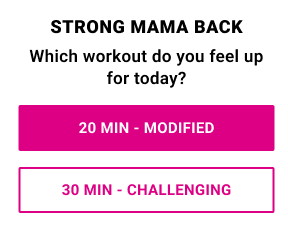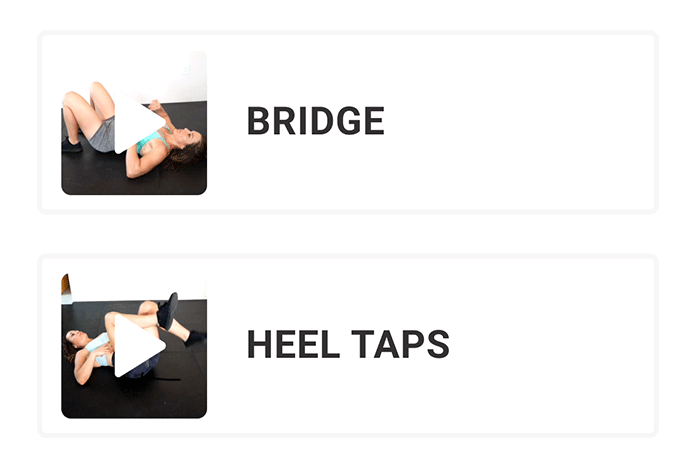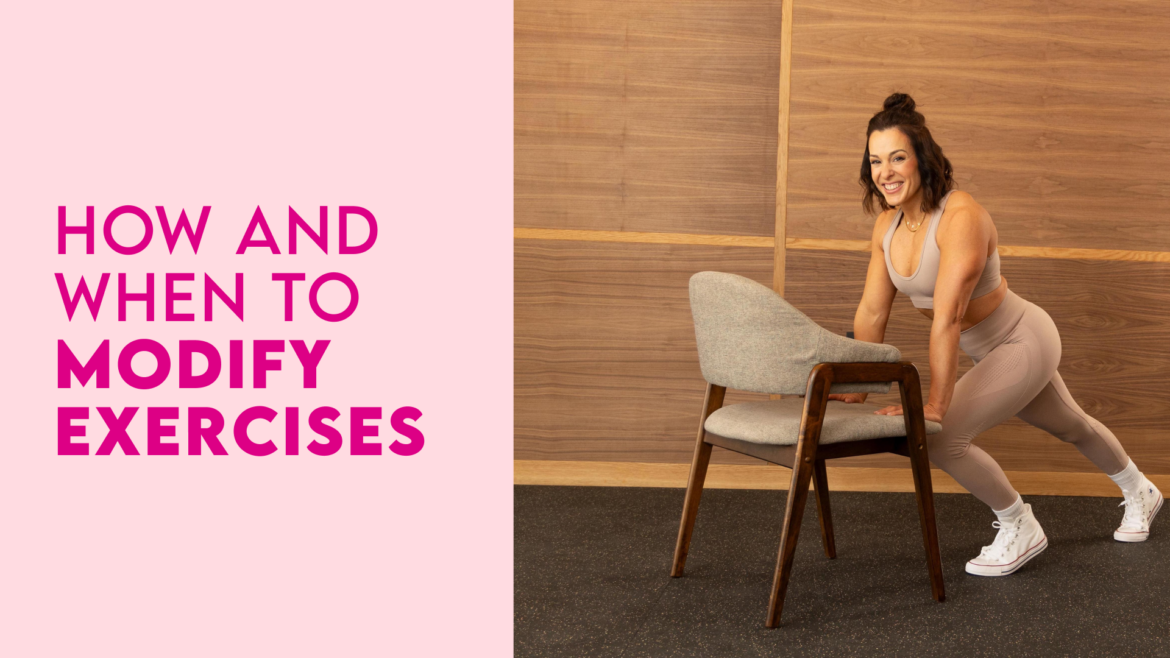Do you ever look at the day’s workout plan and feel a sense of dread because you know an exercise is going to cause pain? Or you aren’t quite strong enough to do a particular movement? There are many situations where it makes sense – or is necessary – to swap out or modify exercises to accommodate your specific situation.
Let’s look at some of the most common reasons you might need to modify an exercise and some tips to help you (safely) make the most out of your workout:
- Skill level and form
- Pain management
- Pregnancy
- Lack of space or equipment
- Not “feeling” the exercise
1. Exercise Modifications Based on Skill Level and Form:
Remember: good form is critical. Without it, you put yourself at risk of injury, not to mention the exercise probably isn’t going to be as beneficial to your body.
If you find you can’t complete at least 40-50% of the reps in a set with sound form and core integrity (i.e. you find yourself flailing or lifting without using your core), take things down a notch by trying the following:
- Lighten Your Load
Cut down on weights, or don’t use weights at all, and reduce rounds or reps. I always tell myself that something is better than nothing! - Limit Your Range of Motion
Use a shorter stance in lunges, limit the depth of your squats, or stop an overhead press before losing control of your ribs (creating rib boob). - Use a Mirror
Work out in front of a mirror or film yourself so you can create a stronger mind-body connection. This really helps with form. - Consider Your Body’s Proportions
People are unique. For example, it’s a lot harder for a six-foot plus person to do a squat press with a band than it is for a shorter person. Those with very long legs and shorter torsos might be particularly challenged by the core stability needed for dead bugs and marches.
Deep Core: Beginner and Advanced Versions of the Same Workout
SLAM coaches are always available to check form and give feedback via our private Facebook group for SLAM members.
2. Exercise Modifications for Pain Management:
Pain in the knee, wrist, shoulder, hip, lower back…Mom life, aging, injury – it’s hard on the body. Modify exercises as needed if you have sensitive joints.
- HAND/FOOT PAIN:
If you experience pain while doing band work, try using one side as the stabilizer while the other side works.- Affix a long band to something stable – for example, sub archer rows for one-arm standing rows.
- Try using a dumbbell instead of a band. Do a kneeling chop rotation instead of a crossbody band pull.
- WRIST PAIN:
Depending on the exercise there are several wrist modification options.
- Drop your forearms for planks, instead of fire hydrants, do a clam on crack.
- Elevate the surface – try wall tricep pushups instead of tricep dips.
- Work the targeted muscle on your back (supine position) – instead of tricep dips, try a lying overhead tricep extension.
- KNEE PAIN:
- Add a prop to help stabilize/recruit supporting muscles. For example, squeeze a ball while doing squats instead of a wide-stance banded squat.
- SINGLE LEG WORK PAIN:
- Add stability – use one foot as a kickstand. Do a B stance bodyweight squat instead of one-leg bench getups.
3. Exercise Modifications During Pregnancy:
All pregnant mamas should avoid deep twists and rotations, large jumps, anything in the supine or prone positions, and sagittal plane core work (e.g. crunches, planks). Some exercise swaps include:
- Single dumbbell front raises instead of jump snatches.
- Back-stepping lunges instead of forward/backward leaps.
- B-stance bodyweight squats instead of one-leg bench getups.
- Plie squats with a ball squeeze instead of bridge with an overhead ball squeeze.
SLAM Pregnancy is tailored to expectant mothers and incorporates modifications. Any mom-to-be with the goal of working out and continuing SLAM deep into pregnancy needs to be proactive and educated on modifications. And since your energy levels can change day to day, each day you are offered two options: a 20 minute modified version or a 30 minute challenging one:

Can You Do Planks While Pregnant?
Yes! With your doctor’s ok, it should be safe to do planks while pregnant during the first trimester. If planks feel too challenging, bend your knees or keep them on the floor during the plank.
If you notice coning in your belly, that is in an indication that the exercise is too intense and should be avoided. Coning is when a cone-like bulge sticks out of your abdomen when performing certain exercises or lying down. Extensive coning can lead to increased diastasis recti, which is when the abdominal muscles separate during pregnancy.
During the second and third trimester, try these plank exercise modifications instead:
4. Exercise Modifications When There’s a Lack of Space or Equipment:
Here are some alternatives if you’re working out in a small space or lacking equipment:
- Banisters and couch legs can become anchor points for bands.
- Coffee tables, couches, benches, and ottomans double as elevated surfaces.
- Filled water bottles are weights, tied up panty hose or robe ties are bands, kids balls are Pilates balls.
For situations when you don’t have good equipment substitutes, try another exercise. For example:
- Instead of a quadruped ball push with shoulder taps, try an elevated plank with taps.
- Instead of a farmer’s carry march, try a standing hip flexor march with a band.
- Do a push press with dumbbells instead of a squat and press with band.
5. Exercise Modifications When You’re Not “Feeling” the Exercise:
Sometimes you complete an exercise and just don’t feel it – or at least not in the right place. You’ll want to modify exercises by adding props to help your proprioceptive awareness (i.e. knowing where and how your body is oriented in space):
- Use the Wall
Use a wall for feedback on single-leg deadlifts, squats with a foam roller or big ball (behind your back, against the wall). - Add a Band or a Ball
Add a band around your knees or a ball between knees when doing squats, bridges, and hip thrusts. - Roll up Mini Bands
Placing rolled-up mini bands under the toes or heel during standing work ensures you’re making complete contact with the ground. - Make a Wedge
Add a wedge (plate weight, folded up towel, etc.) under your heel for more challenge during squats. - Incorporate TRX Straps
If you have straps, try using them to support and stabilize you during popcorn lunges and jump squats.
Final Thoughts
While this is a long list, it’s not a comprehensive one, nor does “one modification fit all.”
Safety always comes first, so don’t hesitate to break down an exercise to make sure you’re doing it correctly, and in a way that works for your unique body. As always, if you are experiencing chronic pain, check in with your doctor.
Many modifications and substitutions are offered in the SLAM app. They’re typically very similar exercises, “tuned down” a notch or two. For example:
- Bodyweight Exercises: Try bodyweight squats instead of weighted squats
- Lunges: Try back stepping lunge instead of weighted lunge or step ups
- Pushups: Try elevated or wall pushups instead of pushups with shoulder tap
- Planks: Try supported/bent knee side plank instead of side plank with a leg lift or row
- Ab Workouts: Substitute seated options for standing core movements
SLAM coaches are always available to check form and give feedback through our private Facebook group for SLAM members. You can swap or modify exercises in the SLAM app by selecting the ‘swap moves’ feature.


As always, if you are experiencing chronic pain, please see a medical professional.
